Hoover DamThe Hoover Dam By-Pass Bridge was part of the new alignment of U.S. Highway 93 across the Black Canyon between Arizona and Nevada and was located approximately 1,500 feet downstream of Hoover Dam. Total length from abutment to abutment was approximately 1,090 feet. The structure was the first concrete-steel composite arch bridge built in the United States and includes the longest cast-concrete arch in the Western Hemisphere. The Obayashi Corporation and P.S.M. Construction USA, Inc. Joint Venture (Obayashi/PSM JV) was awarded the bridge construction contract by The Federal Highway Administration (FHWA). HDR Engineering, Inc., and T.Y. Lin International were the bridge design team. For construction of the bridge, the By-Pass lifting system was a luffing cableway as defined by the American Society of Mechanical Engineers (ASME) B30.19 – Cableways. Four lattice towers, each approximately 330 feet tall, were erected on either side of the Colorado River immediately south of the Hoover Dam. Distance between the opposing towers (span) was approximately 2,500 feet. The two cableways extended parallel and along the centerlines of the double highway lanes of the new bypass bridge. Each tower could lean (luff) in the north/south direction to provide lifting capabilities for the load block to reach the entire width of each of the double highway lanes. Lower and upper load blocks were supported by a carriage that was positioned along the spanned length by inhaul and outhaul ropes on the track cables (gut lines). During high winds on September 15, 2006, the Nevada South tower buckled and collapsed. During the collapse, the falling sections severed multiple support cables of the Nevada North tower causing it to fall to the north. The resulting collapse of both Nevada towers imparted dynamic loading to the two Arizona towers, causing both to fall westward toward the Black Canyon of the Colorado River. Haag Engineering Co. was retained to determine factors causative of the collapse and evaluate duties and responsibilities of the parties involved in the design, erection and use of the specialized equipment. During recovery efforts, Haag assisted in the design/evaluation of a new cableway system, erection and load testing. The Haag team was assigned to the project from collapse on September 15, 2006 until the connection of the arches in 2010. Haag’s Jim D. Wiethorn, P.E., head of the Crane Group in Houston, lead the project. The Hoover Dam By-Pass Bridge was sucessfully completed after this set-back, and officially named the “Mike O’Callaghan–Pat Tillman Memorial Bridge”. Opening ceremonies were held on October 19, 2010. The bridge has been a vital to improving traffic on Interstate 93, between Phoenix and Las Vegas and between the United States and Mexico, ever since. |
Desaturation Testing—Available NOWHaag Research & Testing is the only lab in the US to offer an IAS Accredited desaturation testing protocol. Most desat projects are completed within 10 business days after samples are received. We’ve completed hundreds of desaturation tests, and are accepting new projects now! Contact Haag Research & Testing today, 214-614-6500
|
|
Jim D. Wiethorn, P.E., Haag Chairman and Principal Engineer, is the head of Haag’s Crane Group based in Sugar Land, TX. Haag’s crane group investigates all aspects of the crane and rigging related accidents. Jim Wiethorn is a third-generation general contractor and has owned, operated, and used cranes throughout his professional career. In order to better understand and become more involved in the crane industry, Jim became a member of the National Commission for the Certification of Crane Operators (NCCCO) on the Tower Crane Committee and Rigging Task Force Committee. Jim also serves as a member of the American Society of Mechanical Engineers (ASME) B30 Main Committee, Safety Standard for Cableways, Cranes, Derricks, Hoists, Hooks, Jacks and Slings, as well as the ASME B30.3-Tower Cranes and ASME B30.29-Self-Erect Tower Cranes sub-committees. Jim has testified in over 200 depositions and 100 trials during his career. Wiethorn serves on the Board of Advocates of the Engineering and Computer Science School, Baylor University and the Engineering Advisory Board of the Cockrell School of Engineering, University of Texas at Austin. |
|



